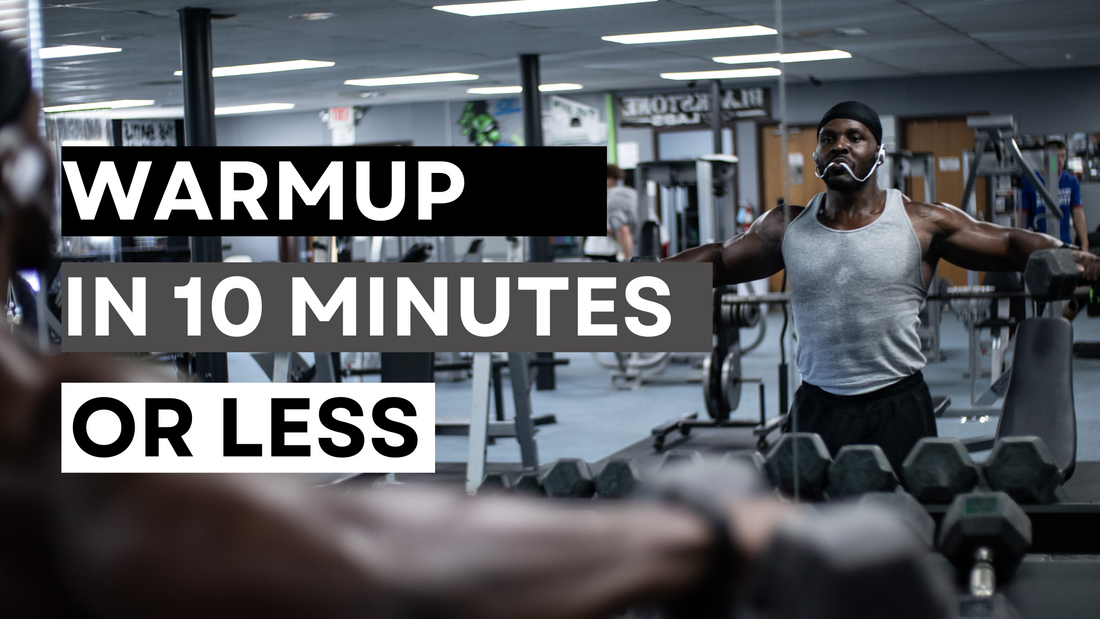
Warm Up More Effectively, AND In LESS Time.
Quit Wasting 10-15 Minutes on Pointless Warm Ups:
Look around the gym, or perhaps you're guilty of this yourself.. Scanning in at the front desk, music blaring in your headphones, preworkout kicked in... and BOOM now you have to figure out what to do for a warmup.. So like most you opt for some random movements you've seen on Social Media under the page of a "Mobility Guru". Yet, you wonder why your performance is not better, or why you still have chronic aches and pain that you attribute to just "Going Too Hard"
Trust me, I get it:
We all aren’t exercise enthusiast, and the goal is usually just to get in and get out of the gym.. After all, if you feel good why the heck would you need a warmup anyways? Well i'm here to let you know that the warmup is CRUCIAL and you can—and should—set your thinking higher than "Random Movements" when it comes to your warmup.. As it will enhance performance and help prevent training related injuries.
Phase 1: Targeted SMR (Foam Rolling, Lacrosse Ball, TheraGun)
Foam Rolling has been demonized by most and explained as having no true benefit. Well, I beg to differ.
You need to however be focusing on problematic “trigger points”. This will be the most effective foam rolling method for athletes and clients to begin their mobility and pain free movement pursuits.
So, instead of rolling across entire muscle belly's haphazardly.. slowly roll until you discover an area that simply feels like tender or painful.. be sure you are NOT on bone... Trust you’ll know when you find one. Prioritize one area at a time and invest 30-60 sec total with the SMR technique of your choice and utilize a oscillatory technique combining trigger point work with small manageable movements of your body over the area.
This phase should be the shortest.. The goal is to focus on alleviating pain, improving mobility, and moving on to more meaningful phases that involve movement.
Phase 2: Bi-Phasic Positional Stretching
With all the floating beliefs in regards to “stretching decreasing performance before your workout”, this method seems to be the best of both worlds.
Typically, when the conversation of stretching decreasing performance comes about, it’s in reference to STATIC STRETCHING (Think Jr. High Gym).. Whereas, DYNAMIC stretching has been touted as being the better alternative.
“Bi-phasic” meaning two parts or phases.. combines both. Following 30-45 seconds of oscillation back and forth, a 20-30 second end range stretch is performed. Understand this final part should still be controlled by proper muscular tension and correct positioning.
If you really want to reap the full benefits, perform a form of SMR (foam rolling, lacrosse ball, etc) before performing a corresponding Biphasic Stretch. (i.e foam roll quads, then perform this hip flexor stretch).
Phase 3: Corrective Exercise
"Corrective” Exercises are subjective.. But, I do believe that every movement or exercise must be done appropriately before adding load or intensity. If you google "corrective exercises" you will find an exercise library decorated with bands, kettlebells, PVC pipes, and that will without a doubt confuse you.
This doesn’t have to be complicated! When in doubt, think of a weakness that you may have.. For example, your knees cave in excessively during a squat.. Instead of just loading poor movement quality by just squatting anyways with weight.. Add a band above the knees and focus on "pushing" against the band and activating the glute medius while doing a goblet squat with lighter weight to reinforce proper movement mechanics. (Reactive Neuromuscular Training)
This Phase 3 block should take the longest, but it’ll help you to reap the benefits of the warm up, and help you maintain a functional and pain-free body.
Phase 4: Muscle And Pattern Activation
The goal thus far has been to open up proper movement patterning or regions to allow new ranges of pain free motion. However, any improvements are useless—and possibly dangerous—without having the ability to stabilize in that new found positioning.. Insert muscle and patterning activation exercises.
These "drills" involve an understanding of mind-muscle connection, and the ability to generate internal tension and force generation. Because in order to optimally “activate” a muscle, you have to feel the muscle contract, then be able to carry over that feeling to a compound or isolation movement.
No matter what movement you choose, thinking about squeezing the active muscles as hard as possible, hardwiring the connections of muscles moving and stabilizing into a new range. For example, you foam roll the hip flexors, do some biphasic stretching then add a band above the knees and lay down to perform some glute bridges before your main movements of the day that could involve deadlifts, hip thrusts, or squats.
Phase 5: Central Nervous System Potentiation
You’re almost ready. And honestly this phase could be considered "optional" depending on your level of fitness and readiness. This phases focus is on being as explosive and powerful as possible, with some central nervous system (CNS) stimulation.
High-velocity-based movements, are the perfect fit for this pre-training preparation phase.
Some options include:
- Lower body: Jumps or short sprints
- Upper body: Medicine ball throws, slams, plyo pushups
- Total body: Seal jacks or rotational medicine ball tosses
Be sure to match the type of CNS work with the big movement of the day. For squat-based movement days, pick vertical jumping for this phase. Deadlifting? or Thrusting?.. broad jump or bound fits well. Bench press or back day? Medicine ball presses or slams are ideal.
For CNS priming, Do not overdue it.. volume should be low, but intent HIGH. Avoid fatigue of the CNS and peaking too soon, as you could undue all the great work you've done so far. Stick to 2-3 sets of 2-5 reps of any of these methods, and no more than 15 total reps in one session.
There ya have it! Lock IN.